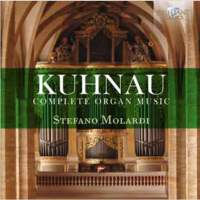Texte paru dans: / Appeared in: |
|
| "... enthusiastically recommended." |
Outil de traduction ~ (Très approximatif) |
|
Reviewer: James
A. Altena In 35:1 and 38:5 I previously gave attention to releases of sacred vocal music by Johann Kuhnau (1660–1722). This set brings us what is advertised as being the composer’s complete surviving organ works. Since Kuhnau generally did not specify any particular type of instrument for his keyboard works, and since most previous recordings of them have been made on harpsichord and clavichord, this description is liberally employed by organist Stefano Molardi (who provides the informative booklet notes for this release) as inclusive of all of the composer’s keyboard works suitable for performance on organ. In any case, it is good to have them now assembled into one convenient collection—especially since several of those previous recordings are now out of print—and at Brilliant’s super-budget price to boot.
With this release, definitely count me in among Kuhnau’s more recent enthusiasts. Admittedly, his inventiveness does not equal that of Buxtehude before him, or of his immortal successor at the Thomaskirche after him; but it is quite engaging on its own terms, nowhere more so than in the Biblical Sonatas that are his keyboard masterpieces. Early examples of program music, each of these has its movements underscored at the beginning with specific written indications of the Old Testament episodes that the music portrays. For example, the First Sonata, “The Combat between David and Goliath,” consists of the following movements: “The boasting of Goliath”; “The trembling of the Israelites at the Appearance of the Giant, and Their Prayer to God”; “The Courage of David, and His Keen Desire to Repel the Pride of His Terrifying Enemy with the Confidence that He Puts in the Help of God”; “The Combat between the Two and their Struggle”; “The Stone is Thrown from the Slingshot – Goliath Falls”; “The Flight of the Philistines, who are Pursued and Slain by the Israelites”; “The Joy of the Israelites over their Victory”; “The Musical Concert of the Women in Honor of David”; “The General Rejoicing, and the Dances of Joy of the People.”
The seven sonatas of the Frische Clavier Früchte also employ Italian musical forms. In style, however, these works, and likewise in the assorted individual works featured here—some freestanding pieces, and others taken from the two volumes of the composer’s Neuer Clavier Übung of 1689 and 1692—are far closer to German models in their sound world. Indeed, some movements seem to look back past Buxtehude to earlier composers of the mid-17th century, such as Tunder or Weckmann, though the more lively ones clearly draw their inspiration from recent Italian models.
The performances here are
exemplary. In particular, for all of the Biblical Sonatas I find the use of
an organ infinitely preferable to that of a harpsichord or clavichord, as
the former is capable of the extraordinary range of coloristic effects these
pieces need in order to come fully to life. Comparing these performances to
those in the long out of print Harmonia Mundi set by John Butt (which
utilizes organ in four of the sonatas and clavichord in two), I also find
that I prefer Molardi’s interpretations overall, although Butt employs some
imaginative effects (such as bells) that the latter does not. For example,
the complaint of dull scholasticism by Youngren and Strickland gains some
traction when one hears the excessively slow tempo that Butt adopts for “the
trembling of the Israelites”; if Molardi perhaps errs in being a bit too
fast here, his take on the movement is infinitely preferable. Both players
perform on instruments from Kuhnau’s own lifetime. Molardi’s notes provide
detailed descriptions of the effects he adopts for each of the movements of
the Biblical Sonatas, as well as extensive discussions of the other sonatas
and passing remarks on the shorter works. There is also a brief artist bio,
and lists of specifications for the two Silberman organs utilized. Brilliant
Classics offers a winning entry here that all aficionados of Baroque organ
music will want to snap up without delay; enthusiastically recommended. | |
|
|
|
|
Cliquez l'un ou l'autre
bouton pour découvrir bien d'autres critiques de CD |
|




